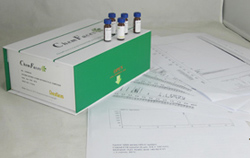Hot Products



| Catalog No. | Information |
| CFN97032 | 2-Hydroxy-1,8-cineole 1. 2-endo-Hydroxy-1,8-cineole shows antimicrobial and bactericidal activities against against test bacteria (Staphylococcus aureus, Escherichia coli, and Pseudomonas fluorescens) . |
| CFN92111 | 2-Hydroxy-1-methoxyanthraquinone 2-Hydroxy-1-methoxy- anthraquinone has antiosteoporotic activity, it can promote osteoblast proliferation, and can inhibit osteoclast TRAP activity and bone resorption. |
| CFN92112 | 2-Hydroxy-3-(hydroxymethyl)anthraquinone 2-Hydroxy-3-(hydroxymethyl)anthraquinone exhibits quinone reductase (QR)- inducing activity in Hepa lclc7 cells, with the concentration required to double QR activity of 0.94 microM. |
| CFN99810 | 2-Hydroxy-3-methylanthraquinone 2-Hydroxy-3-methylanthraquinone enhances apoptosis of U937 cells,in part,through activation of p-p38MAPK and downregulation of p-ERK1/2; triggers caspase-3 activation mediated apoptotic induction. |
| CFN98193 | 2-Hydroxycinnamic acid 2-Hydroxycinnamic acid has photooxidant activity; 2-hydroxycinnamic acid germanium has strong inhibitory effect on the tumor U14; trans-2-hydroxycinnamic acid has efficacy against trichlorfon-induced oxidative stress in wistar rats. |
| CFN97687 | 2'-Hydroxydaidzein 2'-Hydroxygenistein is an isoflavonoid phytoalexin, it suppresses chemical mediators in inflammatory cells, may have value in treatment and prevention of central and peripheral inflammatory diseases associated with excess production of chemical mediators. 2'-Hydroxygenistein shows significant concentration-dependent inhibitory effects on the release of beta-glucuronidase and lysozyme from rat neutrophils in response to formyl-Met-Leu-Phe/cytochalasin B (fMLP/CB) with IC(50) values of 2.8+/-0.1 and 5.9+/-1.4 microM, respectively. |
| CFN90346 | 2-Hydroxyeupatolide 2-Hydroxyeupatolide has anti-inflammatory activity,it may suppress the inflammatory response through inhibiting the activation of NF-κB signaling pathways, and make a contribution to further understanding the pharmaceutical activity of Eupatorium plants. |
| CFN99257 | 2'-Hydroxygenistein 2'-Hydroxygenistein has antifungal activity, dimerization of it causes a remarkable increase of antifungal activity. It shows significant concentration-dependent inhibitory effects on the release of beta-glucuronidase and lysozyme from rat neutrophils in response to formyl-Met-Leu-Phe/cytochalasin B. 2'-Hydroxygenistein of genistein can enhance its antioxidant activity and cell cytotoxicity in MCF-7 human breast cancer cells. |
| CFN97950 | 2-Hydroxynaringenin The recombinant protein exhibits high FNS I activity catalyzing the conversion of naringenin to apigenin and 2-Hydroxynaringenin. |
| CFN95197 | 2-Methoxy-5-acetoxy-furanogermacr-1(10)-en-6-one Reference standards. |